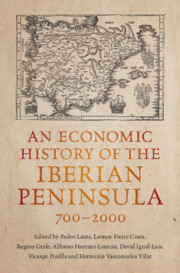Book contents
- An Economic History of the Iberian Peninsula, 700–2000
- An Economic History of the Iberian Peninsula, 700–2000
- Copyright page
- Contents
- Figures
- Tables
- Contributors
- Preface: By Way of Presentation
- Introduction
- Part I The Making of Iberia, 700–1500
- Section I The Early Middle Ages, 700–1200
- Section II The Medieval Economy, 1000–1500
- 2 Production, 1000–1500
- 3 Population, 1000–1500
- 4 The Polity, 1000–1500
- 5 Money, Credit and Banking, 1000–1500
- 6 Technology, 1000–1500
- 7 Living Standards, 1000–1500
- 8 International Trade and Commerce, 1000–1500
- 9 The Iberian Economy in Global Perspective, 700–1500
- Part II Globalization and Enlightenment, 1500–1800
- Part III Industrialization and Catching Up, 1800–2000
- References
- Index
2 - Production, 1000–1500
from Section II - The Medieval Economy, 1000–1500
Published online by Cambridge University Press: 22 February 2024
- An Economic History of the Iberian Peninsula, 700–2000
- An Economic History of the Iberian Peninsula, 700–2000
- Copyright page
- Contents
- Figures
- Tables
- Contributors
- Preface: By Way of Presentation
- Introduction
- Part I The Making of Iberia, 700–1500
- Section I The Early Middle Ages, 700–1200
- Section II The Medieval Economy, 1000–1500
- 2 Production, 1000–1500
- 3 Population, 1000–1500
- 4 The Polity, 1000–1500
- 5 Money, Credit and Banking, 1000–1500
- 6 Technology, 1000–1500
- 7 Living Standards, 1000–1500
- 8 International Trade and Commerce, 1000–1500
- 9 The Iberian Economy in Global Perspective, 700–1500
- Part II Globalization and Enlightenment, 1500–1800
- Part III Industrialization and Catching Up, 1800–2000
- References
- Index
Summary
This chapter focuses on the development of Iberian Christian societies from 1000 to 1500. It deals with the evolution of output, its composition and how it spread across space. Therefore, the study sets out the main chronological and territorial milestones in the Christian economy: (a) the period of growth and expansion of the eleventh to thirteenth centuries, and that of the crisis and recovery of the fourteenth to fifteenth centuries; and (b) the areas in which economic activities were carried out, taking into account landscape features and different forms of resource used by agricultural, manufacturing and commercial activities. Throughout the text, it is possible to see that the economic model of Iberia in the Middle Ages coincided with some of the European patterns, although it presented original aspects linked, for example, to the Christian war against al-Andalus, to the demands of military supplies and to the role of the spoils of war in the construction of individual and collective fortunes. On the whole, however, the results of economic development were remarkable and do not support the undoubtedly hasty images of Iberia as a peripheral region, located in the extreme south-west of the European continent.
- Type
- Chapter
- Information
- An Economic History of the Iberian Peninsula, 700–2000 , pp. 47 - 75Publisher: Cambridge University PressPrint publication year: 2024



